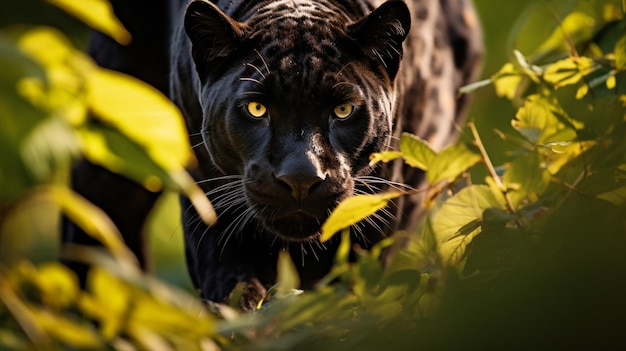

Did you know that jaguars are the third-largest big cat species in the world?
Jaguars are known for their beautiful and distinctive spotted coats.
It’s interesting to note that jaguars have the strongest bite force among all big cats.
Unlike many other big cats, jaguars are skilled swimmers and enjoy spending time in water.
Jaguars are native to the Americas and are found mainly in rainforests, swamps, and grasslands.
A unique feature of jaguars is their ability to climb trees, which is uncommon among big cats.
Jaguars are exceptional hunters and have been known to prey on a wide range of animals, including deer, monkeys, and even caimans.
Their short and powerful legs allow jaguars to move quickly and stealthily through their habitat.
One interesting fact about jaguars is that they have a keen sense of hearing, which helps them locate prey.
Jaguars are known for their territorial behavior and use various vocalizations to communicate with one another.
Unfortunately, jaguars are currently classified as a near-threatened species due to habitat loss and illegal hunting.
Jaguars have a strong cultural significance in many indigenous communities in the Americas.
In some traditions, jaguars are considered spiritual beings and symbolize power and strength.
Did you know that a group of jaguars is called a jamboree?
Female jaguars are smaller in size compared to males but are equally as skilled hunters.
Jaguars have the ability to adapt their hunting techniques based on their prey’s behavior and location.
Jaguars have a complex and fascinating social structure, with males and females occupying distinct territories.
Unlike other big cats, jaguars have a distinctive black morph, with a darker coat color and increased black spots.
The jaguar’s scientific name, Panthera onca, reflects its close evolutionary relationship to other big cats like lions and tigers.
There have been reported cases of melanism in jaguars, which results in a completely black coat.
Jaguar cubs are born blind and completely dependent on their mothers for the first few months of life.
It’s fascinating to learn that jaguars can store excess food by burying it in the ground or hiding it in trees.
Jaguars are excellent ambush predators, often relying on their camouflage to surprise their prey.
A jaguar’s roar is so powerful that it can be heard up to two miles away.
The conservation of jaguars plays a vital role in maintaining the balance of the ecosystems they inhabit.
Jaguar populations are often used as an indicator of the overall health and diversity of their ecosystems.
Efforts are being made to reintroduce jaguars into areas where they have been locally extinct, such as the United States.
The Aztecs and Mayans revered jaguars and often depicted them in their artwork and mythology.
In some indigenous cultures, wearing jaguar skin or using their body parts in ceremonies was believed to provide protection and strength.
Jaguars have been featured prominently in literature and popular culture, often symbolizing stealth, power, and mystery.
The speed and agility of jaguars have been referenced in several sports team names and logos.
In some regions, farmers struggle with conflicts between jaguars and livestock, prompting the need for innovative solutions.
The black jaguar, often referred to as a black panther, is not a separate species but rather a color variation of the jaguar species.
The iconic Jaguar car brand derives its name from the sleek and powerful nature of the animal.
Jaguars are solitary animals, with males and females typically coming together only for mating purposes.
Jaguars have a distinctive, deep-chested body structure, giving them the ability to take down large prey.
The name jaguar is derived from the Native American word yaguar, meaning he who kills with one leap.
Jaguars have a considerably larger range compared to other big cat species, spanning from the southern United States to Argentina.
The intricate, rosette-like patterns of a jaguar’s coat serve as camouflage in the dappled light of the forest.
Jaguars have a unique adaptation called the third eyelid, which protects their eyes from being scratched or injured during hunts.
Conservation organizations are using technology, such as camera traps and satellite tracking, to study and protect jaguars in the wild.
Some ancient civilizations believed that jaguars had the power to communicate with the spiritual world.
In captivity, jaguars have been known to live up to 23 years, longer than their counterparts in the wild.
Jaguar populations face threats not only from habitat destruction but also from conflicts with humans in expanding urban areas.
By learning about jaguars and spreading awareness, we can contribute to their conservation and ensure their survival for future generations.
Around the world, coffee enthusiasts enjoy Monin coffee concentrate since it is a multipurpose product. Conveniently combining…
The Importance of Choosing the Right Shower for Your Bathroom Renovating your bathroom can be…
Usain Bolt holds the record for the fastest 100-meter sprint in history.Bolt was named Sportsman…
Love is in the air... and it smells suspiciously like chocolate!Roses are red, violets are…
Life's a beach, take a picture and relax.Sun, sand, and salty kisses. That's what beach…
Hungary is home to the largest thermal water cave system in the world.The Rubik's Cube…